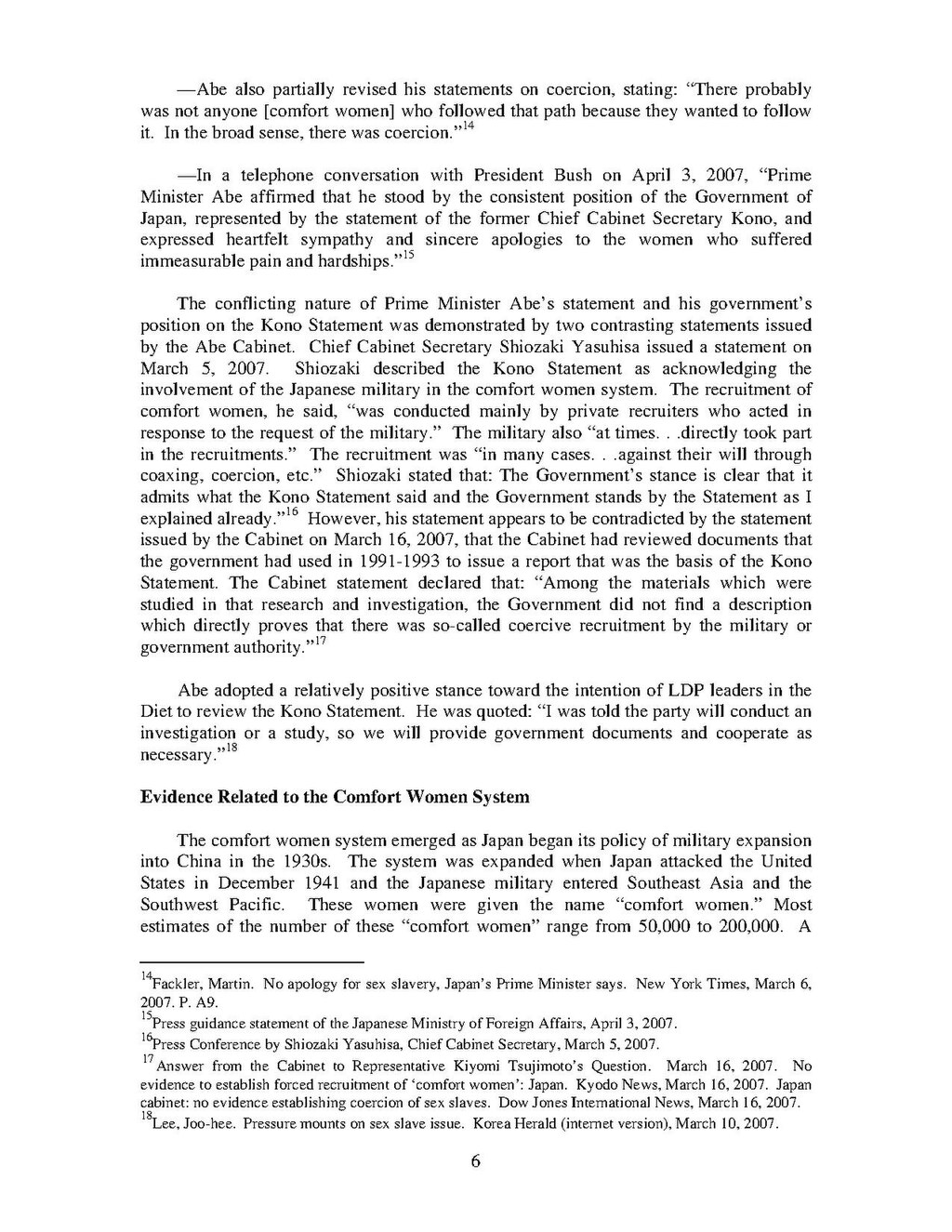—Abe also partially revised his statements on coercion, stating: “There probably was not anyone [comfort women] who followed that path because they wanted to follow it. In the broad sense, there was coercion.”[1]
—In a telephone conversation with President Bush on April 3, 2007, “Prime Minister Abe affirmed that he stood by the consistent position of the Government of Japan, represented by the statement of the former Chief Cabinet Secretary Kono, and expressed heartfelt sympathy and sincere apologies to the women who suffered immeasurable pain and hardships.”[2]
The conflicting nature of Prime Minister Abe’s statement and his government’s position on the Kono Statement was demonstrated by two contrasting statements issued by the Abe Cabinet. Chief Cabinet Secretary Shiozaki Yasuhisa issued a statement on March 5, 2007. Shiozaki described the Kono Statement as acknowledging the involvement of the Japanese military in the comfort women system. The recruitment of comfort women, he said, “was conducted mainly by private recruiters who acted in response to the request of the military.” The military also “at times…directly took part in the recruitments.” The recruitment was “in many cases…against their will through coaxing, coercion, etc.” Shiozaki stated that: The Government’s stance is clear that it admits what the Kono Statement said and the Government stands by the Statement as I explained already.”[3] However, his statement appears to be contradicted by the statement issued by the Cabinet on March 16, 2007, that the Cabinet had reviewed documents that the government had used in 1991-1993 to issue a report that was the basis of the Kono Statement. The Cabinet statement declared that: “Among the materials which were studied in that research and investigation, the Government did not find a description which directly proves that there was so-called coercive recruitment by the military or government authority.”[4]
Abe adopted a relatively positive stance toward the intention of LDP leaders in the Diet to review the Kono Statement. He was quoted: “I was told the party will conduct an investigation or a study, so we will provide government documents and cooperate as necessary.”[5]
Evidence Related to the Comfort Women System
The comfort women system emerged as Japan began its policy of military expansion into China in the 1930s. The system was expanded when Japan attacked the United States in December 1941 and the Japanese military entered Southeast Asia and the Southwest Pacific. These women were given the name “comfort women.” Most estimates of the number of these “comfort women” range from 50,000 to 200,000. A
- ↑ Fackler, Martin. No apology for sex slavery, Japan’s Prime Minister says. New York Times, March 6, 2007. P. A9.
- ↑ Press guidance statement of the Japanese Ministry of Foreign Affairs, April 3, 2007.
- ↑ Press Conference by Shiozaki Yasuhisa, Chief Cabinet Secretary, March 5, 2007.
- ↑ Answer from the Cabinet to Representative Kiyomi Tsujimoto’s Question. March 16, 2007. No evidence to establish forced recruitment of ‘comfort women’: Japan. Kyodo News, March 16, 2007. Japan cabinet: no evidence establishing coercion of sex slaves. Dow Jones International News, March 16, 2007.
- ↑ Lee, Joo-hee. Pressure mounts on sex slave issue. Korea Herald (internet version), March 10, 2007.
6
